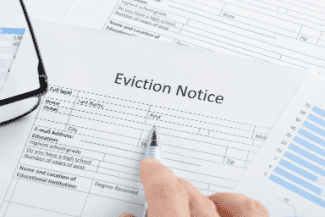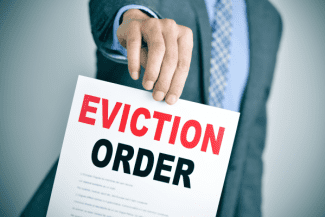How to Evict a Tenant From a Rental Property
You did everything right — credit checks, calling previous landlords and references, criminal background checks.
But despite your careful screening, the tenant who seemed perfect turns out to be a nightmare. At some point, every landlord finds it’s necessary to evict a tenant.
Common Reasons Eviction May Be Required

You may also need to evict a tenant for violating the terms of the lease or rental agreement. For example, having a pet when the agreement has a no-pets clause or making excessive noise that disturbs neighbors and other tenants.
Finally, tenants can be evicted for causing serious damage to the rental premises or carrying on illegal activities, like dealing drugs.
In some cases, even though your tenant hasn’t done anything wrong, there are reasons you may still need to end their tenancy. For instance, if you need to occupy the rental unit yourself.
The Eviction Process
If this is your first time evicting a tenant, the eviction process may seem daunting and have you wondering whether there are any landlord rights available to you at all.
The good news is that the eviction process is often quite streamlined compared to the length of time required for other civil lawsuits.
The rules regulating the eviction of a tenant do vary from state to state, and it’s important to follow the specific requirements set out by your particular state to the letter, as doing so will help increase your chances of a smooth and successful eviction.
What Can You Do to Move Things Along?
Even when faced with a tenant who owes a lot of back rent, or one who’s doing a lot of damage to your property, you should never give in to the temptation to take matters into your own hands.
Doing so will cause a lot of problems, potentially subject you to fines and penalties and greatly hamper your efforts to evict your tenant.
So even though you think it might help you get rid of an unwanted tenant, you should never, without a court order, change the locks, lock out your tenant, or shut off utilities such as electricity, gas and water.
Initiating the Eviction
In order to initiate the eviction process, you will first need to provide some form of written eviction notice or notice of eviction letter to your tenant.
You may get lucky and in response to the eviction notice your tenant moves out, or pays the rent he or she owes you, or stops violating the terms of the rental agreement.
However, if nothing is remedied and the tenant doesn’t move out, you’ll need to file an eviction lawsuit, also known as an unlawful detainer lawsuit.
Types of Eviction Notice
There are three basic types of eviction notices that apply to the eviction of tenants who have misbehaved in some way (this is known as “for cause”). The requirements and names of the notices will vary from state to state.
Depending on the state in which you live, you may be required to provide your tenant with one of the following types of eviction notices:
The Pay Rent or Quit Notice
Pay rent or quit notices are used when the tenant owes you rent. These notices give the tenant a short time period—in most states, between three to five days—in which to pay the rent owing or move out.
The Cure or Quit Notice
Cure or quit notices are used when the tenant is in violation of a specific term or condition of the lease agreement (for example, smoking in the rental unit when the agreement contains a no-smoking clause). Generally the notice will give the tenant a specific period of time to correct the violation or move out.
The Unconditional Quit Notice
Unconditional quit notices require the tenant to vacate the premises without giving them any chance to pay the rent owing or correct their bad behavior. Many states will only permit the use of unconditional quit notices in certain, specific situations, such as:
- Being late with the rent more than once
- Violating a term or condition of the rental agreement on multiple occasions
- Causing serious damage to the rental premises
- Conducting illegal activities on the premises, such as drug dealing or engaging in gang-related activities
In some states, however, the unconditional quit notice may be the only notice required, in which case, while you can give your tenant an opportunity to remedy the problem, you have no legal obligation to do so.
Eviction Without Cause

Sometimes you may need to terminate a month-by-month tenancy when your tenant hasn’t done anything wrong. They pay their rent regularly and on time, and haven’t violated any of the terms of the lease, but you still want or need to end their tenancy.
Depending on your state’s laws and regulations, it can usually provide your tenant with a 30-day notice to vacate or a 60-day notice to vacate.
If your rental property is in an area covered by rent control regulations, you may be required to prove that you have a legally recognized reason for terminating the lease or evicting the tenant.
Contents and Delivery of the Eviction Notice
Each state has different requirements as to what information is required in an eviction notice. When preparing an eviction notice, you may find an eviction notice template, such as a Notice to Pay Rent or Quit, useful as a starting point.
States also vary regarding the method of delivery or service of the notice to the tenant. It’s important to follow these requirements closely, as tenants can use mistakes and irregularities in content or delivery as a defense.
The Eviction Lawsuit
In some cases, tenants won’t move out or fix the problems even after they’ve received the eviction notice.
If this happens, you’ll have to begin an eviction lawsuit by filing the proper documents at your local courthouse and properly serving the tenant with a copy of the eviction complaint and the related summons.
If you win the eviction lawsuit, you’ll receive a court order for possession of the property. But even with this court order in hand, you can’t remove the tenant and his or her property yourself.
This is known as self-help eviction, and isn’t permitted. Instead, you will need to go to the local sheriff or marshal and pay a fee for them to remove the tenant for you.
The sheriff or marshal will give the tenant notice that a law enforcement official will return in a set number of days and physically remove the tenant if he or she hasn’t already moved out of the premises.
No landlord enjoys having to deal with a bad or deadbeat tenant. The eviction process isn’t a simple one, but by following your state’s rules and requirements regarding eviction, you’ll increase your chances of a successful eviction.
Source: Legal Zoom















 Accessibility
Accessibility